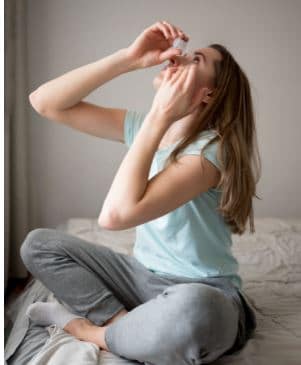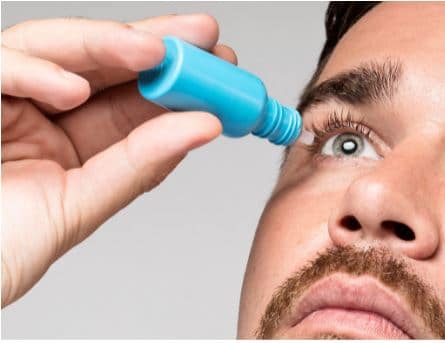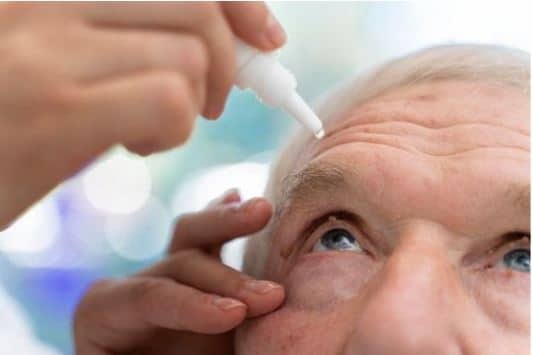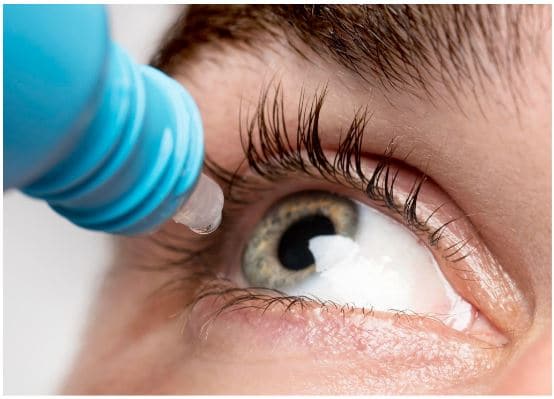Eye drops consist of a saline solution. we use it as moisturizing the eye. treating some bacteria that cause some eye diseases. reducing redness. besides using as a part of the treatment of glaucoma to control eye pressure levels. which is one of the main glaucoma risk factors.
Uses of Eye drops in :
- before some surgeries to reduce the chances of infection.
- dilate the pupil.
- and numb the area around the eye for surgery.
- in addition to after the surgery to speed up the recovery.
Types
Eye drops treat some simple diseases. such as eye burning or itching. and a person can feel positive results by simply using these drops. especially if he/she has minor symptoms as a result of eye exposure to some irritants such as dust or cosmetics.
In the case of any chronic or more serious diseases. the patient must immediately go to an ophthalmologist.
and not search for the appropriate treatment option on his own. because eye drops need a prescription to contain more effective substances in their composition.
so the Royal Spanish Center advises you to not use these eye drops until after referring to a specialist doctor.

1- Dry eye drops:
Some people suffer from dry eyes and irritation. especially in the fall and winter. People with this condition feel a burning or itching in their eyes. Therefore, some lubricating drops or artificial tears are used, which contribute to alleviating symptoms and reducing their severity.
And there are some advantages and disadvantages to using those eye drops, some of those advantages are:
- Helps moisturize the eyes by replacing natural tears with artificial tears.
Reduce pain and irritation. - If there are any scratches in the eye caused by dryness, these drops help heal the surface of the eye.
- Get rid of pollutants that may be present inside the eye.
Reduce the possibility of further damage or injury to the eye. - wrong use of these drops makes defects.
- Not all patients can use the same type of drops. as what is suitable for one person may not be suitable for another and may result in sensitivity or irritation.
- Improper use may lead to more severe complications.
2- Drops to treat redness:
Some people experience redness in one or both eyes as a result of many diseases such as allergic conjunctivitis, eyestrain, or overuse of contact lenses, and sometimes red eyes can be the result of more serious conditions such as glaucoma.
In the case of redness of the eyes resulting from some simple diseases such as eye strain or allergies, decongestant eye drops can help get rid of the redness by narrowing the blood vessels in the eyes, but in the case of more serious diseases such as glaucoma, the redness of the eyes is accompanied by more serious symptoms, and therefore the patient should go to the doctor for an immediate examination so that the patient does not suffer from serious complications such as loss of vision.

3- Eye drops to treat allergies:
Eye allergies occur as a result of exposure to allergens such as dust, germs, pet dander, some chemicals, or body secreting an excessive amount of histamine, which is reflected in the eyes with irritation and redness, and this allergy is treated through some drops that contain antihistamines and work within five minutes of application and its effect can last up to 12 hours.
4- Antibiotic eye drops:
Some eye diseases occur as a result of a viral, bacterial, or fungal infection, and each of them has a different treatment, in the case of any bacterial infections, some antibiotic eye drops resist the bacteria causing inflammation and reduce symptoms, and speed up recovery.
and these eye drops are also used after the surgeries to avoid any complications caused by any bacteria or infection, which can cause many problems, the most important of them is the negative impact on the surgery that the patient underwent.
5- Moisturizing eye drops:
Many people suffer from simple and non-chronic dry eyes. especially people who use contact lenses frequently. as contact lenses affect the amount of oxygen in the eye. affecting the moisture of tissues and membranes.
which ultimately leads to a feeling of dryness in the eyes. Therefore they must use moisturizing eye drops. which covers the cornea until the tissues begin to recover. At the same time, a layer protects the eye from damage.
6- Glaucoma eye drops:
High intraocular pressure can contribute to glaucoma. which is one of the most serious eye diseases as it requires immediate examination by the specialist doctor and the speed of choosing the appropriate treatment.
complications that can contribute to permanent vision loss. Thus, we use a certain type of drops. which mainly works to maintain safe levels of intraocular pressure to ensure that the disease does not worsen.
but use these types of drops are only with a prescription from an ophthalmologist. Through this article, you can learn more about glaucoma and how it is treated at the Royal Spanish Center
Tips before using eye drops:

- Wash your hands well with soap and water.
- do not touch the eyes, eyelids, or eyelashes.
- If there is a separate dropper and it touches the eyes, throw out the drop immediately.
- if you put the dropper back into the liquid, the liquid will become contaminated and you could get an infection again.
- Do not share drops or eye ointments with anyone else.
- If you wear contact lenses.
- try not to use them during the treatment with eye drops.
- in order not to get eye dryness, and use them only after consulting your ophthalmologist.
- Make sure that the head of the drop is not broken. in order not to cause any scratching to the eye. and make sure it is clean before usage.
How to apply:
- Wash your hands first with soap and water.
- Tilt your head back.
- Pull the eyelid down to open the eye sac and put fluid into it.
- Gently tap the drop.
Do the same with the other eye. - Close both eyes for a minute.
- tilt your head.
- look down to help the eye absorb the fluid and help it spread throughout the eye.
- Wash your hands after you have finished so that you do not spread any infection anywhere else.

